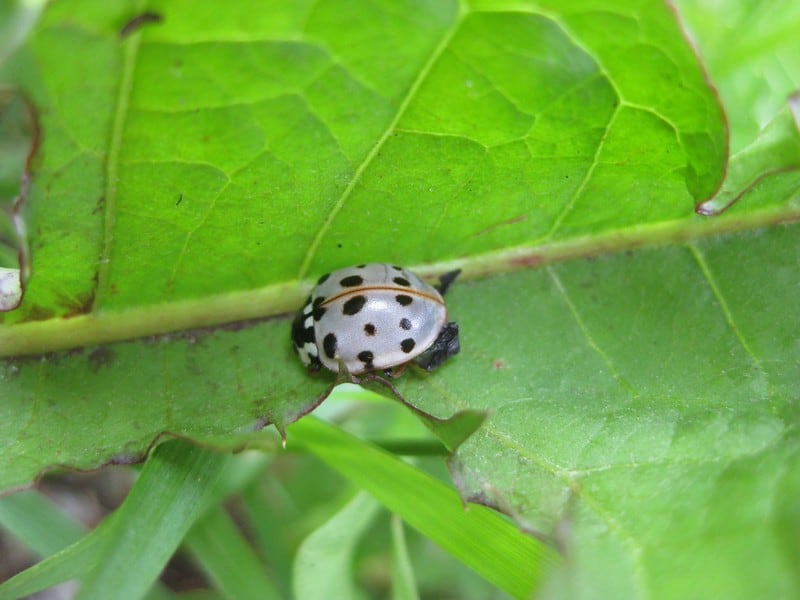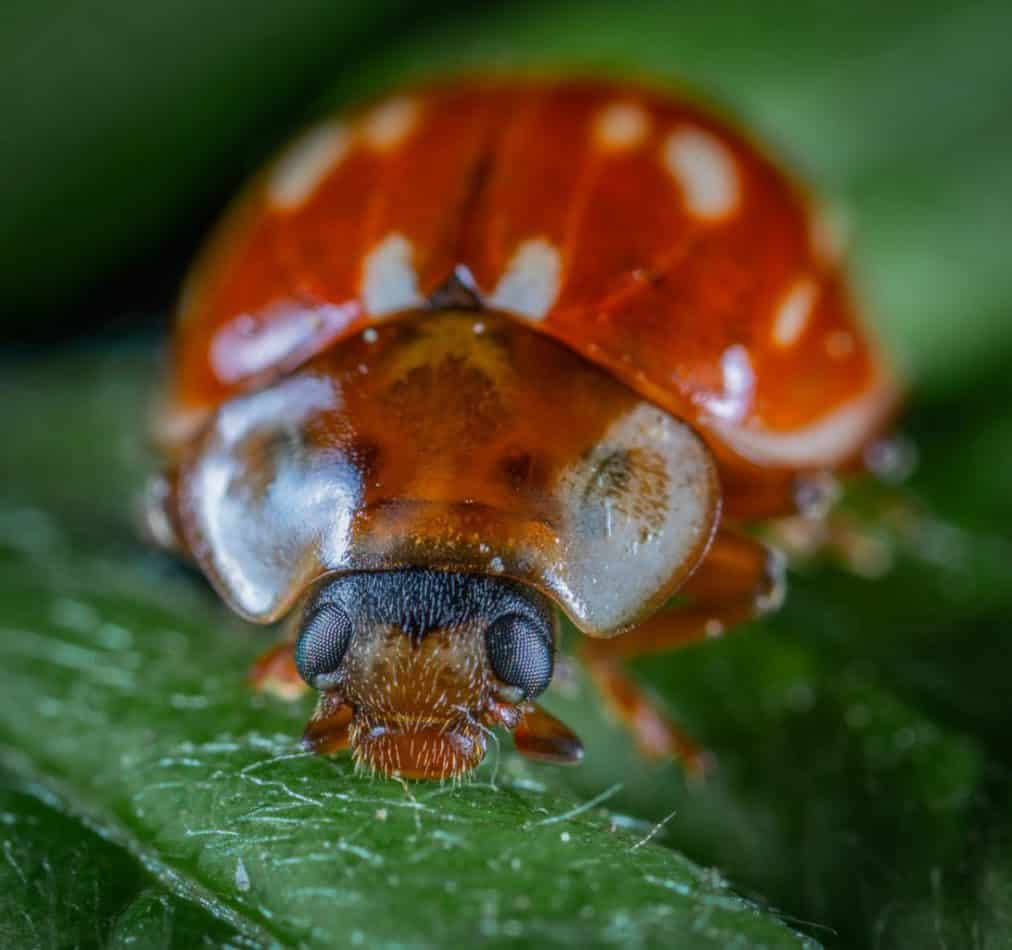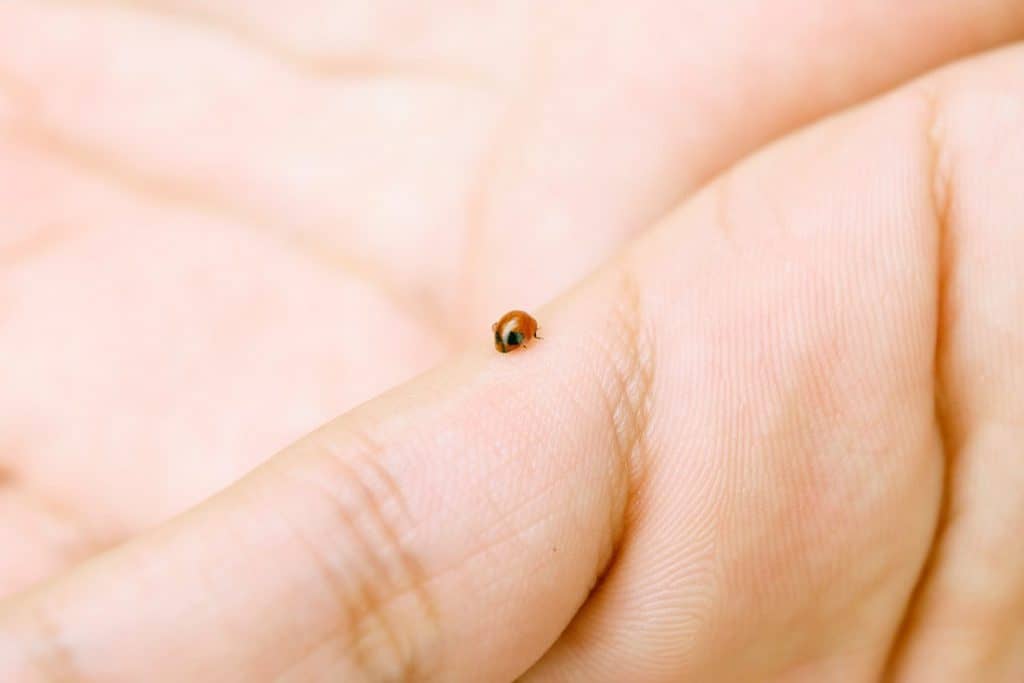
If you enjoy reading this article, why not check out our articles on Are All Ladybugs Girls? and Do Ladybugs Build Nests?

I’ve always loved how the ladybugs look. They have always been a picture of cuteness and just plain adorable, in my opinion. As I did some digging around about the behavior of our dear ladybugs, it leads me to an article talking about if the ladybugs like light or dark. The article detailed why ladybugs can get attracted to both light and darkness, depending on the situation and time of day. I then wondered how ladybugs see the world.
How do ladybugs see? Ladybugs have a compound eye structure that sees in shades of black and white. They are not able to see any color at all. It is the reason why ladybugs are more attracted to light-colored flowers when they hunt for food.
It really took me by surprise how beneficial these creatures are in our garden. Their voracious appetite for aphids and other crop-eating bugs really makes them a gardener’s best friend. I mean, I remember my grandma squishing them because she believed that they are pests. Boy, she was so wrong about that (sorry grandma). Moving on to the real topic, which is the way the ladybugs see. I think it is just right to give you a brief intro of the ladybug’s anatomy before jumping into discussing how they see.
Other insects have interesting vision as well. Ever curious if butterflies can see color? Find out here: Can Butterflies See Color?
The Anatomy Of The Ladybug
The ladybug has three major body parts, and these are the head, thorax, and abdomen. The head contains the eyes and antenna while the thorax, which is called the pronotum, is a body segment of the ladybug that is right behind the head. The pronotum’s primary purpose is to help protect the head of the ladybug during dangerous situations. The abdomen is where the legs of this adorable beetle are attached. It is also where the wings, elytra, and of course, all the ladybug’s internal organs, including their reproductive system, can be found.

An elytra is the hard covering or the hard cuticle that covers the real wings of the ladybug. That flapping red or orange wing looking structure with spots is actually an outer shell that houses the ladybug’s actual wings. The wings of a ladybug are transparent and thin. It is always folded and hidden underneath the elytra when the ladybug is not flying. Ladybug legs are always black and short. They are not only for moving around, but they are also used by ladybugs to gather scents. It is also where that foul-smelling liquid oozes out when a predator tries to eat them.
The Eyes Of The Pretty Lady, I Mean The Ladybug
Ladybugs have compound eyes, which means that they can very much see and pick up movement from all directions. Compound eyes are a kind of insect eyes where the whole eye is made up of tiny eyes that pick up information from the environment. These tiny eyes are called ommatidia, and the more ommatidia the insect’s eyes have, the more detailed the image is.
The ladybug’s compound eyes allow them to see the difference between light and dark. This means that this little critter can only see in shades of black, white and grey. Their compound eyes are not capable of seeing in colors. Experts who have studied ladybugs extensively says that although they have compound eyes, they do not have that good of an eyesight. The ladybugs are nearsighted beetles, meaning they can only see clearly when an item is very near them. Now, don’t let that get you down because even if the ladybug can only see in shades of grey and nearsighted, they are capable of seeing in most directions. They can pick up movements far better than we humans do.
Night Time And The Ladybug’s Vision

As I keep on digging and reading facts about ladybugs, I then realize that if ladybugs cannot see that clear, then most probably ladybugs cannot see well when it’s dark. My assumptions were proven correct when I started pursuing this topic more. It turns out; ladybugs cannot see in the dark at all. They lack a particular eye part called tapetum lucidum.
According to a research paper that I read online, “A tapetum lucidum is a biological reflector system that is a common feature in the eyes of the vertebrates.” It means that this particular eye part is responsible for allowing many vertebrates to see in low-light levels.
Now since ladybug’s eyes do not have a tapetum, they are not able to see in low-light situations, let alone in the dark. Nighttime is when the ladybugs sleep. Yes, you read it right. Ladybugs do sleep. They enter a state of stasis where they stop physically moving, but their bodily functions, especially their digestive functions, continue its operations. This unresponsive state can last for hours, about one whole night until the sun comes up and warms the ladybugs again.
I don’t really see the point in ladybugs developing a tapetum lucidum. They are cold-blooded creatures and are not able to move their body without an outside source of heat (mainly the sun). A tapetum lucidum would only allow them to see in the dark but will not allow them to move if they are in trouble.
Do you think other creatures, like spiders, can see in the dark? Read our article Can Spiders See in the Dark to find out!
Reason Why You Might Find Ladybugs In Dark Areas Even With Poor Eyesight
We’ve established that ladybugs have a black and white vision. They can only see in shades of grey with no color at all. And since they are blind in low-light settings, it is reasonable to assume that they would avoid dark places. That is where you are wrong.
Ladybugs are active during the day since this is when they can use their eyes to hunt for their food, but during nighttime, they need to find a shelter where they can rest. Keep in mind also that ladybugs are cold-blooded creatures, which means that they rely on external sources of heat to keep them warm and mobile as they hunt. With the dropping of the sun, the temperature drops too. It is the time when a ladybug usually finds some shelter.
Ladybugs don’t necessarily like the light or dark: their anatomy and the way they are created dictates when they can move about. The main reason why you might find ladybugs in dark areas is when they are overwintering or hibernating. The dark areas are usually the best place for them to do that because it is often the driest and warmest place.
The Antenna Is What Helps Ladybugs See

Mother nature has given these cute and lovable little critters something to help them survive and thrive in our environment. Their antennas serve as a supplementary eye so that they can effectively locate their prey as they navigate the world. Most insects use their antennas the same way, and some even use it for communication. So there really is no reason to feel bad about ladybugs being color blind. They are well equipped to survive their environment even if they can only see clearly in short distances.
Even if the ladybug has poor eyesight and can only see a blurry black and white image, they have developed something that helps them navigate the world other than their feet. Their antennas are what helps them feel, smell, and taste their surroundings.
Conclusion
To quickly recap what we have discussed in this article, here is a summary. Ladybugs are actually beetles. Their anatomy is divided into three major parts. The head, thorax, and abdomen; the head is where the eyes are located. Ladybug eyes are compound eyes, which means that their eyes are made up of many lenses and not just one like we humans have. It allows the ladybugs to see in different directions at once. These compound eyes also help ladybugs capture movements in short distances very clearly. However, ladybugs are color blind. Their eyes are not capable of seeing colors, which means that they see the world in shades of grey. You can compare their eyesight to a blurry black and white picture.
Next is we discussed the ability of ladybugs to see in the dark. It turns out; ladybugs lack a unique feature in their eyes called the tapetum lucidum. This tapetum lucidum is what enables the eyes to see in low-light settings. Since the ladybugs lack this feature, they are not able to see in the dark. Ladybugs do sleep, and they enter a state of stasis where they remain unresponsive for hours. We also established that the number one reason why you might see a ladybug in dark places, even if they are not able to see in the dark, is because these dark places are usually the warmest and driest places in their vicinity. And we all know that ladybugs need some warmth when they hibernate during the winter months.
Lastly, we mentioned that even if ladybugs have such poor eyesight, it is their antennas that allow them to feel, taste, and smell their surroundings, thereby, effectively helping them locate their prey in their environment. As you can see, Mother Nature has her way of giving her creations survival mechanisms that would help in their daily lives. The ladybug is no different, they may be colorblind, but they are still predators of garden pests.
If you enjoyed reading this article, why not check out our articles on What are the Biggest Bugs in America? and What is the Largest Insect Swarm?
Recent Posts
Tiny Black Bugs in Bathroom NO WINGS: What They Are and What to Do!
Finding tiny black bugs in your bathroom can be uncomfortable, to say the least. Especially if they are persistent, or they appear in very large numbers, which they often like to do. When it...
Tiny Black Bugs in Plant Soil - What Are They & What To Do About It
A short horror story: You get a new houseplant. You do your best to take care of it. You’ve ensured that it has the right soil, the right amount of sun, it gets enough water. And then one day, you...

